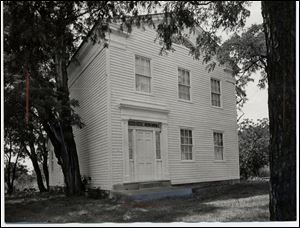
Final rest is elusive for city's pioneers
11/5/2002
The Amos Spafford farm, in a 1974 photo, was the site of a cemetery dating to 1815 in which some of the pioneer families of the Perrysburg area were buried.
Six boxes of bones are stacked in a storage area at Ohio State University Anthropology Lab in Columbus. The 180-year-old fragments sealed inside the boxes mean many things to many people.
To anthropologists like Paul Sciulli, head of the OSU anthropology department, they are “parts of at least seven bodies, two or three of them kids - one child almost complete, and the balance adult males and females” found during digging for the new visitors center and museum at Fort Meigs State Memorial on State Rt. 65 in Perrysburg.
To historians like Perrysburg author Judy Justus, these are probably Spaffords, Joneses, Charters, and Hawleys, pioneers - founders of towns, churches, and businesses. Their names are listed in cemetery censuses dating to 1815, when their little graveyard was part of the Amos Spafford farm.
To Perrysburg native Tonia Spafford Cannon, “These are my great-great-great relatives, my family, people whose remains need to be put back and left in peace.”
And to the Ohio Historical Society, they are “the jurisdiction and responsibility of the city of Perrysburg and Ohio state,” according to spokesman Mike Ring. The Society runs Fort Meigs, an historic recreation of a fort that played a pivotal role in the U.S. victory during the War of 1812.
Last year, workers digging a sewer line outside the new visitors center accidentally unearthed the unmarked pioneer cemetery. They moved coffins, ornaments, and bones to their Columbus lab for analysis, but later turned over the items to Ohio State anthropologists.
Mr. Ring said they washed their hands of the bones: “The Historical Society is completely out of the picture.”
Everyone agrees the pioneer bones will be returned to Perrysburg soon. They were dug from beneath a city-owned road and are officially city property, said Perrysburg administrator Jim Bagdonas. City officials have discussed what to do with the cardboard caskets, but no conclusions have been reached.
Mr. Bagdonas said last week that he hadn't heard anything from Ohio State. He said he won't make a move until he's discussed the matter with Spafford descendents.
The only certainty lies with Mrs. Justus. She intends to see the bodies laid to rest near other Spafford graves at Fort Meigs Union Cemetery, about a half-mile from their original burial ground.
Mrs. Cannon said she hopes the burial will be part of a Spafford reunion, picnic, and plaque dedication planned for May 10. Mrs. Justus said the get-together is part of Perrysburg's observance of the Ohio Bicentennial and that burying the bones would honor Perrysburg's founding families.
“They need to be reburied. Proper words need to be said over them,” Mrs. Justus said.
Bill Spafford, Mrs. Cannon's 76-year-old father, said the discovery of the remains has rekindled his family's dormant interest in their history. Yet he'd rather see the remains buried on the fort site, as close as possible to their original resting place.
“I think the Indians are right,” he said, referring to Native American response to Historical Society prehistoric gravesite removals at the fort.
“You disturb someone's grave, you disturb their rest, their spirit. It's disturbing to the living and the dead to see them removed like that,” he said. “And it's even more disturbing that no one contacted the families involved here.”